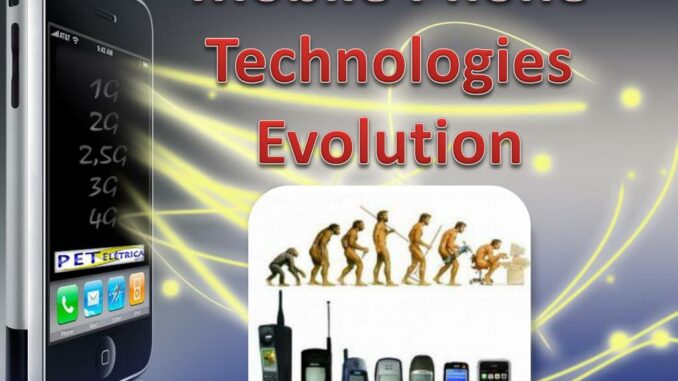
Smartphones have transformed the way we live and work, and have become an essential part of our everyday life. Smartphones have emerged as powerful gadgets that have revolutionized the way we communicate, access information, and engage with the world around us as mobile technology has evolved substantially over the years. Let’s look at how cell phones have evolved and their impact on society.
The first mobile phones were rudimentary devices that could make voice calls and send text messages. These devices were large and costly, with few features and functionality. They were, nonetheless, deemed revolutionary at the time since they provided unequaled mobility and freedom from landline lines.

The first wave of smartphones appeared in the late 1990s and early 2000s, with the development of mobile data networks. These devices were largely used by business people and provided rudimentary internet surfing and email functions. They remained relatively pricey and had limited computing power, but they set the groundwork for future smartphone development.
Apple’s debut of the iPhone in 2007 represented a watershed moment in the growth of smartphones. The iPhone was a game changer, with a sleek design, a huge touch screen, and a plethora of programs available for download from the App Store. This opened up an entirely new world of possibilities, transforming cell phones from simple communication devices into powerful multi-purpose tools.
Smartphones from numerous manufacturers entered the market in the years that followed, offering a variety of operating systems, designs, and capabilities. Google’s Android operating system emerged as a popular alternative to iOS, and smartphones powered by Android soon gained acceptance due to their low cost and customization capabilities.

The advancement of mobile technology has been rapid, with smartphones getting smaller, thinner, and more powerful. Processing power has improved tremendously, allowing smartphones to perform complicated tasks such as gaming, video streaming, and photo editing. Smartphone cameras have greatly improved, with many handsets now featuring high-resolution lenses, numerous camera sensors, and complex photography functions.
Mobile app development has also been a major driving force in the advancement of smartphones. App shops, such as the Apple App Store and Google Play Store, contain millions of programs that cater to a wide range of requirements, including social media, productivity, entertainment, health and fitness, and much more. Mobile apps have changed the way we consume material, connect with businesses, and access services, making smartphones a necessary tool in our daily lives.
Another notable improvement in smartphone technology has been the incorporation of biometric security features like fingerprint sensors and facial recognition. These capabilities have improved smartphone security by safeguarding sensitive data and facilitating secure transactions, making smartphones an indispensable tool for mobile banking, e-commerce, and online payments.

Smartphones have also played an important role in connecting individuals and promoting societal change in recent years. Social media apps have revolutionized the way people communicate and exchange information, serving as a platform for activism, raising awareness, and driving social movements. Smartphones have evolved into an effective instrument for documenting events, capturing memories, and sharing tales, giving individuals a global voice and impact.
Smartphones have had a significant impact on areas such as entertainment, e-commerce, healthcare, and education. Streaming services have grown in popularity, allowing consumers to enjoy information on-demand, at any time, and from any location. E-commerce has grown at a breakneck pace, with mobile shopping becoming the standard for many customers. Users may now track their health and wellness objectives more easily thanks to health and fitness applications while educational apps transformed the way we learned making education more accessible and convenient.
In addition to their societal influence, cell phones have seen considerable developments in design and form factor. Bezels have shrunk, screens have grown larger and more vivid, and devices have become more sturdy and water-resistant. Battery life has increased, and wireless charging is now a standard feature in many smartphones.
Table of Contents
The Third Generation of Smartphones
The third generation of mobile phones, smartphones, brought about the true revolution. The first genuine smartphone, IBM Simon, debuted in 1992, but it wasn’t until the late 2000s that smartphones gained global popularity with the introduction of iconic devices such as the iPhone and Android-based smartphones that they became widely popular.

Smartphones of the Fourth Generation
Smartphones have evolved in recent years, becoming more powerful and complex. Modern smartphones include cutting-edge technologies such as 5G connectivity for faster internet speeds, facial recognition for biometric authentication, augmented reality (AR) and virtual reality (VR) capabilities, dual or triple-lens cameras with advanced photography features, and powerful processors that can compete with traditional computers in terms of processing power.
Smartphones in the Future: Beyond 2023
Smartphones are projected to become even more innovative and transformational in the future. We may see advances in flexible screens, folding smartphones, wearable technologies, and integrated AI (Artificial Intelligence) that will allow us to connect with the environment around us more naturally. Advances in battery technologies, wireless charging, and sustainability efforts to make cell phones more environmentally friendly are also possible.

Leave a Reply